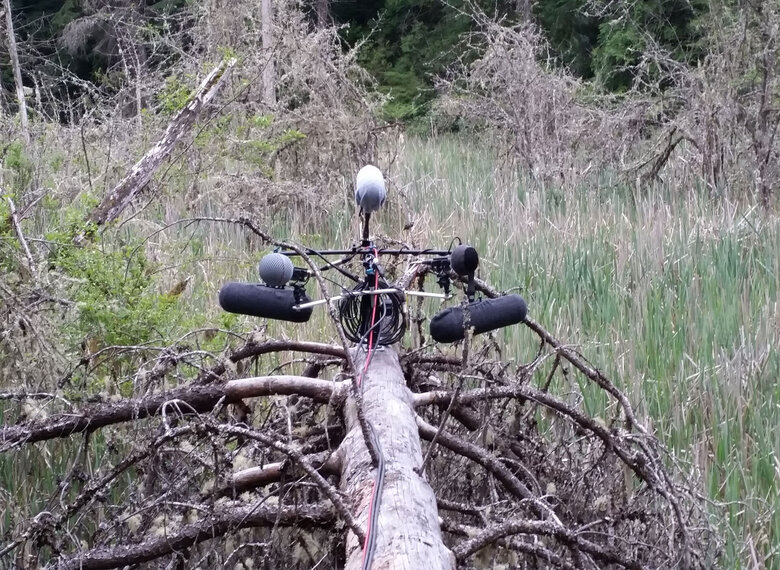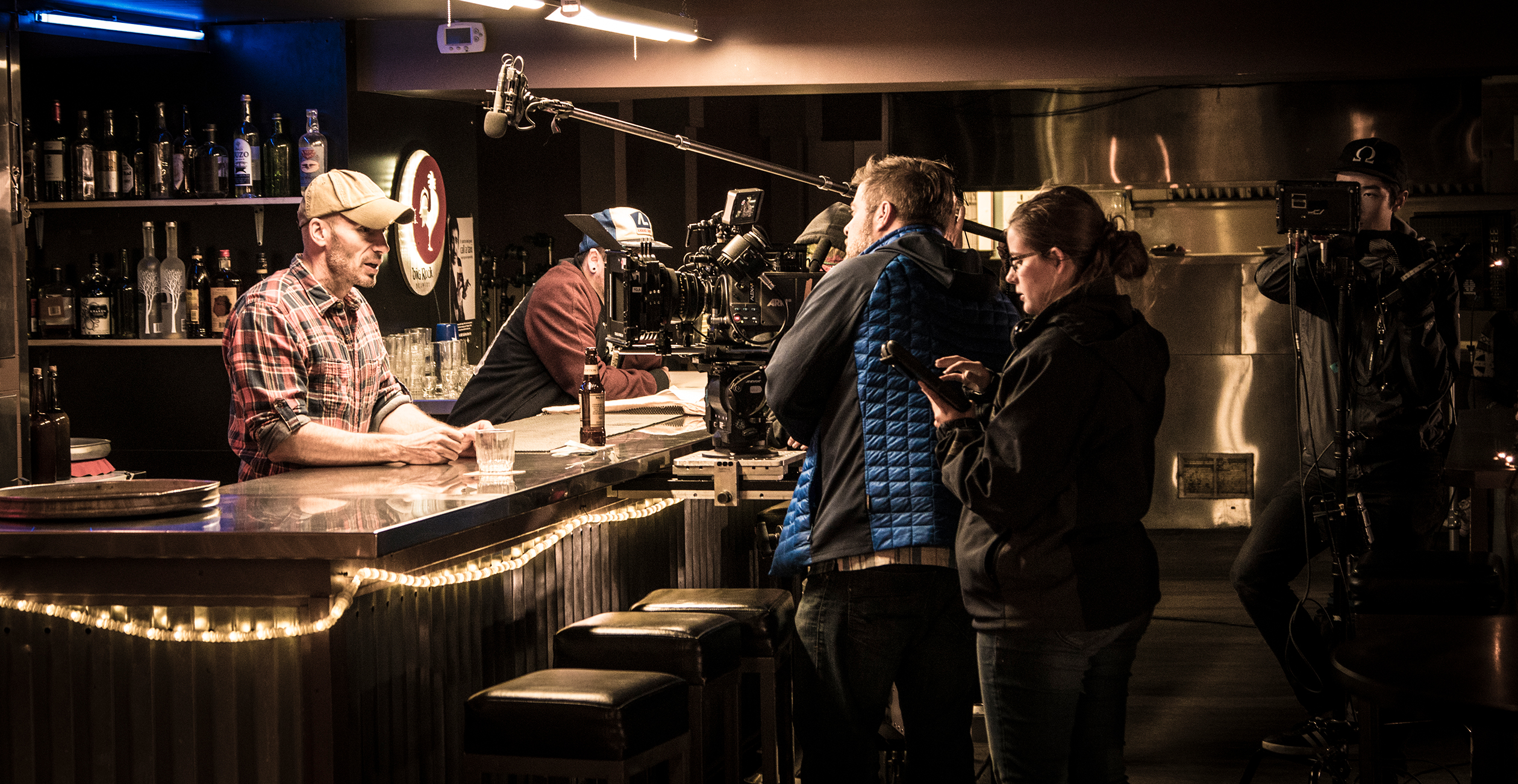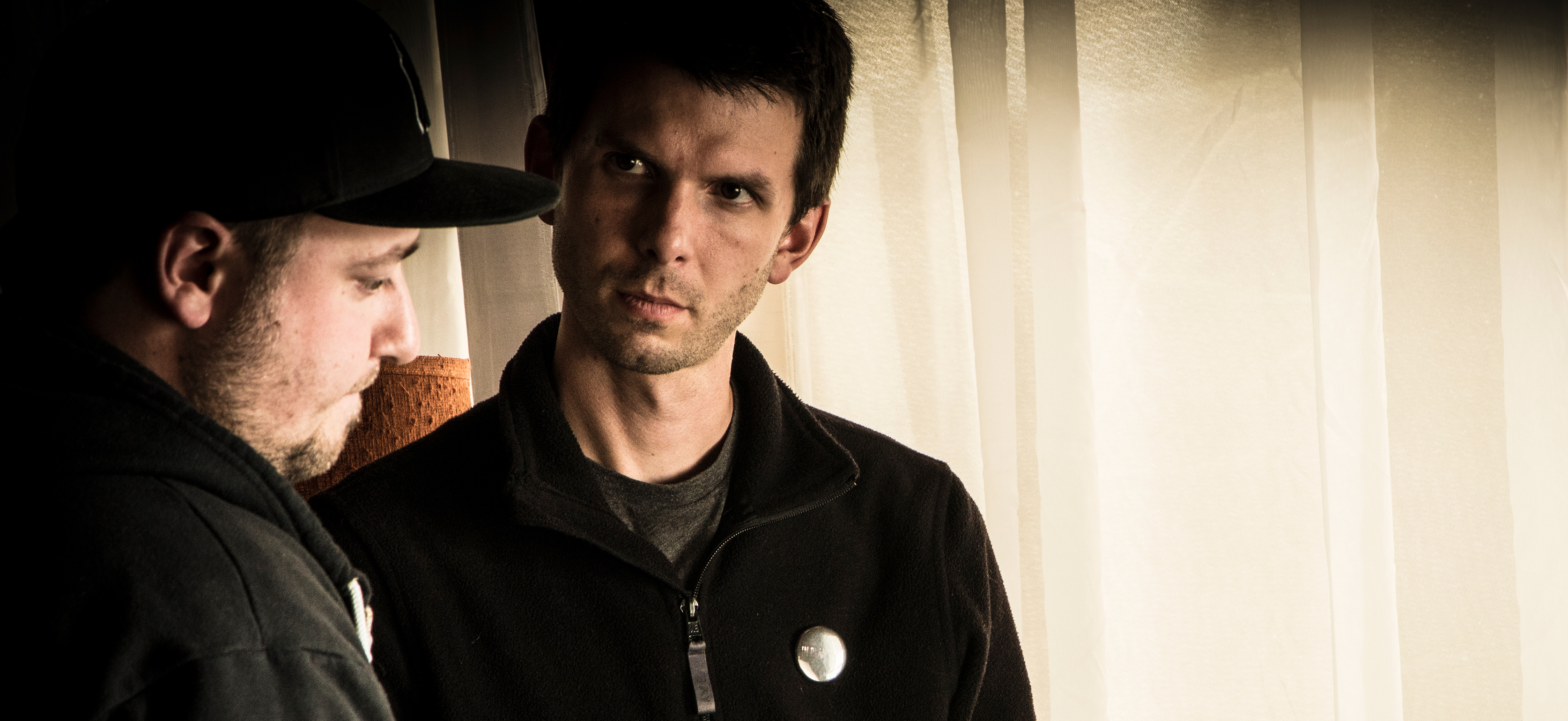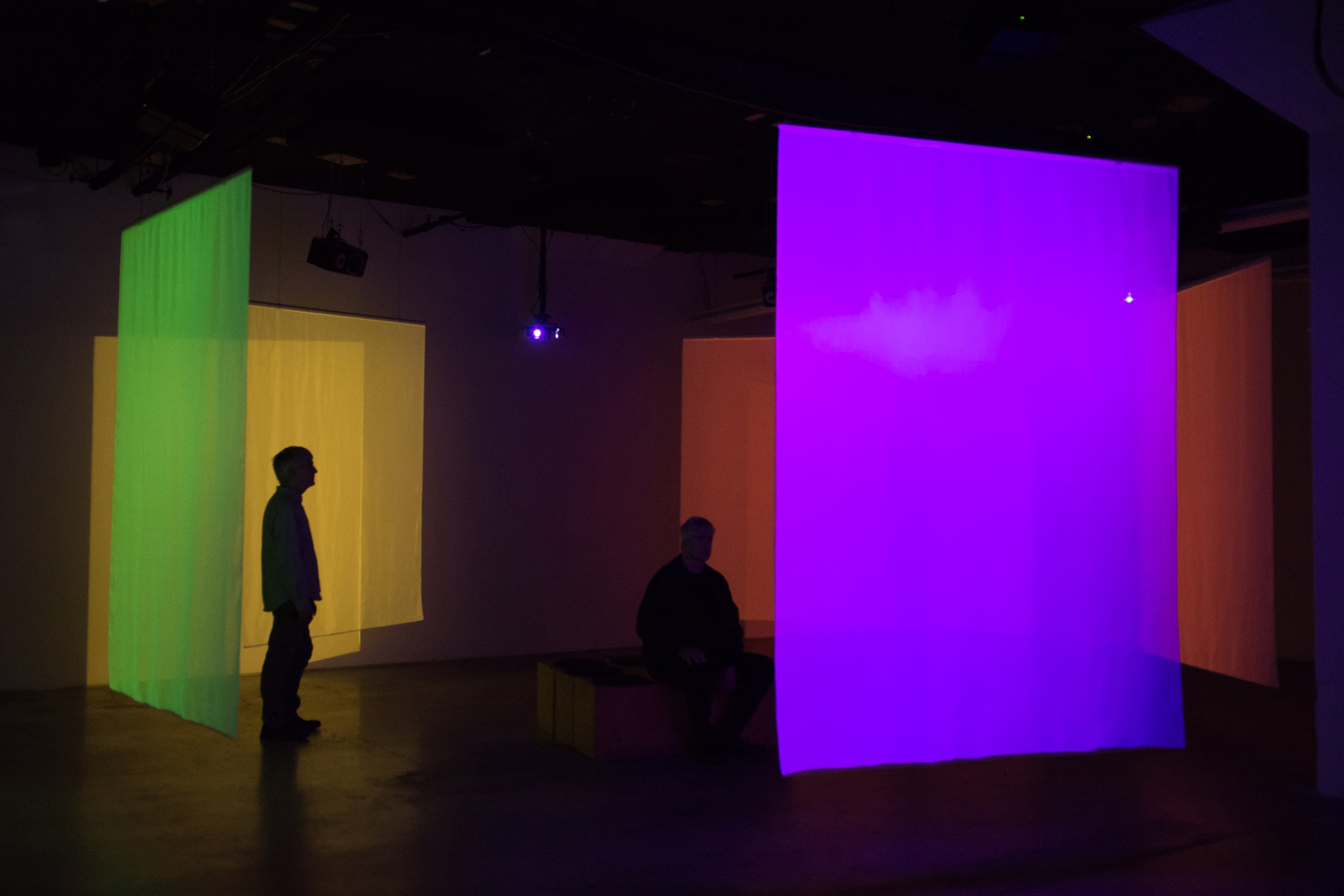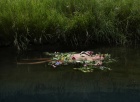It is ten p.m. on Earth Day April 22, 2020, and the Wetland Project 24 Hour Livestream, which I have been tuning in to and out of throughout the day, is alive with the layered voices of hundreds of frogs. The sounds play from my cell phone propped up on my bedside table. The screen undulates with green ripples. I am attempting to read a book, but the insistent croaking is so dense it pushes the words from my mind, driving out linear thought. Eventually, I give up, close my eyes, settle back into the pillows, and absorb the chirping cascade. It is like listening to a waterfall, attempting to isolate individual rivulets and currents within the overall flow. I concede my ears to the frogs and sink into a state of swampy consciousness.
At its core, Wetland Project is a durational sound recording of the endangered ṮEḴTEḴSEN marsh on Saturna Island, BC, located in unceded W̱SÁNEĆ territory. Having lived beside the marsh for many years, multidisciplinary artist Mark Timmings invited digital media artist Brady Marks to the island to document the sounds of the wetland during Earth Week 2016. Together with sound engineer Eric Lamontagne, the artists installed five microphones on a fallen tree trunk in the middle of the marsh. The resulting recording captures a full day and night cycle in the acoustic life of the swamp.
For Earth Day 2017, the Wetland Project recording was broadcast for 24 consecutive hours on Vancouver Cooperative Radio and became the longest uninterrupted broadcast in Canadian radio history. It was also featured on radio stations across Canada and in the US and Europe. The following year, Timmings and Marks collaborated with programmer Gabrielle Odowichuk to create an algorithm to translate the recording into the spectrum of visible light.
The piece was presented as an immersive five-channel installation—a screen for each of the microphones on the log used for recording—at VIVO Media Arts Centre in Vancouver during Earth Week 2018. Wetland Project can be accessed anytime as a web-based, 24-hour livestream that combines the recording with the colour field algorithm. The livestream is synchronized to the local time so that a listener can experience the sounds of the marsh in relation to their own circadian cycle. Elements of the Wetland Project recording have also been interpreted as a musical score by musicologist Stephen Morris and performed by the Saturna Island Community Choir and the Vancouver vocal ensemble musica intima.
The original sound recording used for the livestream has been modified hardly at all, reflecting the artists’ desire to “let nature speak” through “radio that listens in rather than broadcasts out.” 1 Timmings and Marks’ approach is directly inspired by Acoustic Ecology—an interdisciplinary framework developed by members of the World Soundscape Project at Simon Fraser University in the 1970s—for documenting, analyzing, and interacting with sonic environments. 2 When Wetland Project was first created it not only celebrated Earth Day 2016 but also the 50-year anniversary of the founding of the World Soundscape Project.
"Listening to the Wetland Project on the 50th anniversary of Earth Day, I was compelled to accept the restriction of my normal activities and instead see it as an opportunity to be attentive."
My slowing down on that April evening was analogous to the generalized state of standstill gripping the world during the spring of 2020. To reduce the spread of the Covid-19 virus, those who could afford to do so were adapting to self-isolation. Listening to the Wetland Project on the 50th anniversary of Earth Day, 3 I was compelled to accept the restriction of my normal activities and instead see it as an opportunity to be attentive. As speculation about the causes and consequences of the virus circulated in the media, Earth Day 2020 offered a moment to reflect on the social and ecological impacts of the enforced slowing down beyond the reactionary rhetoric of anti-Asian sentiment and economic crisis. 4
Listening to Wetland Project was a richly textured experience. The sounds of the marsh layered with the ambient noise of my life in isolation: the purr of the dishwasher, the soundtrack of my partner’s video game, the much-reduced traffic beneath my window. Whether I used headphones or my stereo speakers to listen to the audio from my phone, I experienced the spatial depth created by the layering of five directional channels of sound recorded from the log. The whine of a fly’s wings was intimately close, a buzzing in my ear. The warbling cry of geese in flight and the drone of a float plane’s engine echoed overhead. A flurry of wings and disturbed water signaled a flock of ducks coming in to land. The occasional creak of a frog throughout the day was a taste of the evening croak-a-thon to come.
To keep an eye on the livestream colour field while I worked, I propped my phone up on my desk and its screen became a synaesthetic portal onto the marsh. Warbling croaks of ducks or geese were turquoise, the high-pitched calls of small birds were bright glimmers of intense colour within the murky green and red of the ambient noise. Around two p.m. the screen pulsed from black to magenta every four seconds or so, as a bird called persistently with a single shrill note. As the thrum of a plane engine entered the soundscape—visible as a collection of violet shades—the punctuating peep now showed up as electric blue, the layering of animal and machine frequencies combining within the algorithm’s output to yield new combinations.
A piece of my mind was occupied with the swamp all day, even as I tuned in and out. The sounds, I reflected, were not merely a surface layer of the ecology, but vectors of affect, inducing action in the marsh’s inhabitants. For me listening at home, a plane drone symbolized the encroachment of people into the wetland, a reminder that human influence is never far away. Indeed, the concept of a pristine wilderness is a conceit: humans have been shaping and changing environments for longer than we have been human, and the idea of a pure nature, separate from us, is only a recent phenomenon. 5 For the inhabitants of the bog, the sounds of human endeavour could be a cause of fear or movement, or simply another background noise to ignore. I began to think of the acoustic landscape as a polyphonic assemblage: the audible traces or expressions of the entanglement of organisms and environment.
In a thoughtful move by Timmings and Marks, the Wetland livestream page also hosts the project’s Twitter feed, allowing a network of active listeners to share comments in real-time. On April 22, 2020, listeners were quick to note the context of the Covid19 pandemic and the calming influence of listening to the marsh during a period of unprecedented anxiety. One listener commented that it was like “Bringing sunshine through the clouds. [A] soothing backdrop to life in quarantine.” 6
What makes Wetland Project so poignant for those who listen to it? I believe the work’s success lies in its slow and durational quality—that it takes time to absorb it—which induces a receptive and contemplative state. Moments of activity emerge from the marsh throughout the day: they are not selectively edited into the sizzle reel like most nature documentaries. The lack of clear visual images requires the listener to use their imagination to reconstruct the marsh environment, aided by the affective qualities of the colour field on screen. Marks observes how the activity in the marsh seems to correspond to the ebb and flow of energy in a listener’s daily routine: “It’s always the right sound at the right time… It’s a full drama that we’re intimately familiar with as the cycle of the day.” 7
While the sounds of the marsh were ever changing, its ambient presence was consistent. For listeners dealing with the incongruity of life in lockdown while witnessing the world in a state of turbulence, Wetland Project offered a window onto a space and time completely outside that of the pandemic. As Michael McCarthy, co-author of The Consolation of Nature: Spring in the Time of Coronavirus reflects, “At this time of chaos in the world of people, nature was a constant, as it has always been. COVID-19 had wrecked, if only temporarily, so many human artifacts; it had stopped business, trade, travel, sports, education, entertainment, and social gatherings of all kinds—but it hadn’t stopped the spring.” 8
Wetland Project, like the many field recordings released for free during the lockdown, allowed people isolating at home to benefit from the therapeutic qualities of nature from afar. 9 The reduction in noise pollution even allowed scientists and artists to create the first global public sound map of the spring dawn chorus. 10 Yet even without the pandemic, access to nature is not evenly distributed among our communities and may be impacted by a number of intersecting issues from social and economic class to physical capacity. Wetland Project—and the broader project of Acoustic Ecology—is a salve to this lack and a testament to the need for more equitable access to nature.
Within the double frame of the onset of the global pandemic and the fiftieth anniversary of Earth Day, listening to Wetland Project on April 22 offered me a moment to reflect on the legacy of the countercultural movement that gave rise to both Earth Day and the discipline of Acoustic Ecology. When it began, the World Soundscape Project aimed to use technologies of communication to document, understand, and advocate for wild places. Fifty years on, the internet, radio, and social media can continue to connect people to nature in new and innovative ways. Recognizing that our experience of nature is often technologically mediated, Wetland Project side-steps the binary of nature/technology to focus instead on how we use these tools to promote multi-species flourishing.
By the time this article is published, Earth Day 2021 will be within sight. When it arrives, I wonder what kinds of fresh reflection and wisdom will I be ready to absorb? Like the best of our seasonal traditions, the annual Wetland Project broadcast is a chance to share stories and take stock. Whether the pandemic lessens or not, I will continue to gather around the “yuletide log of Earth Day,” 11 align myself with the ecology of the wetland in this unhurried way, and allow the frog chorus to demand my attention, as a state of swampy consciousness pulls me down into the bog.
You can experience the Wetland Project here: https://www.wetlandproject.com

